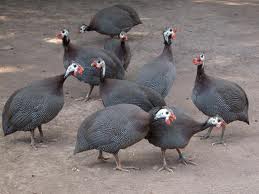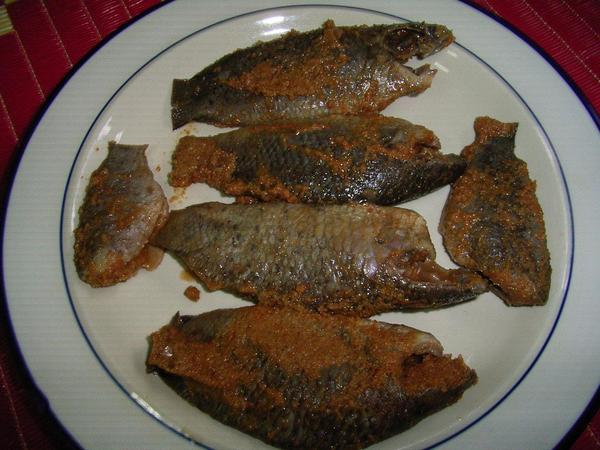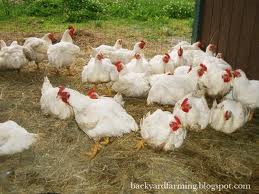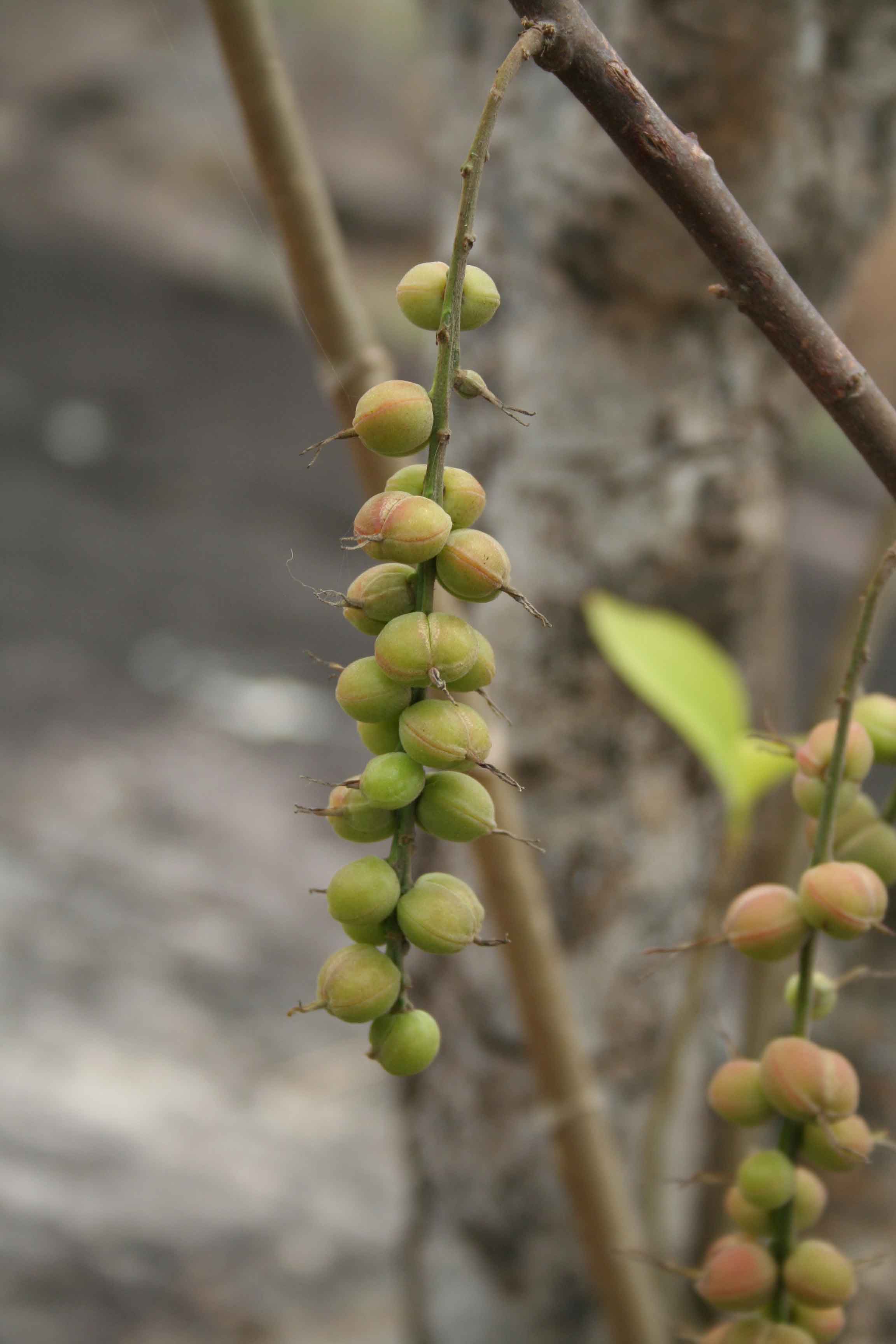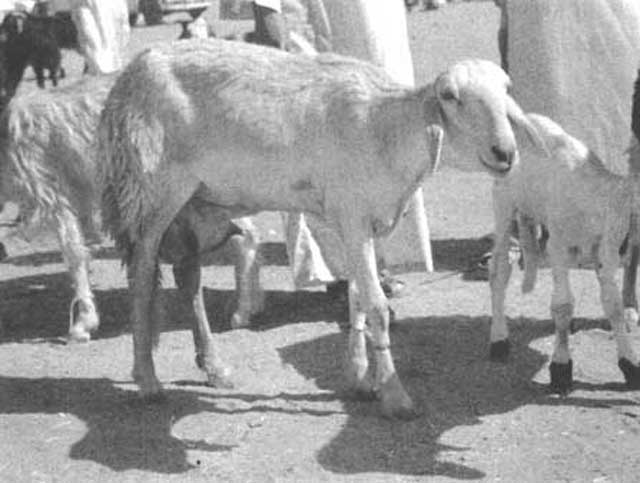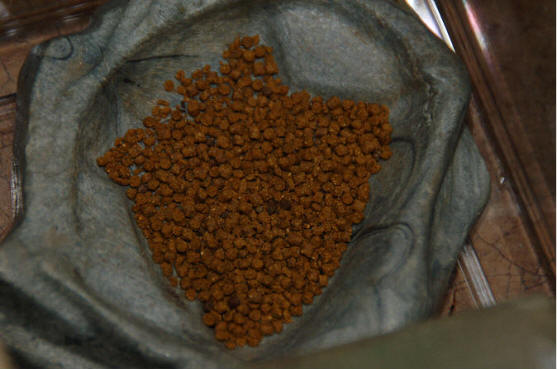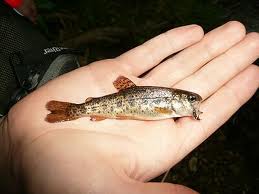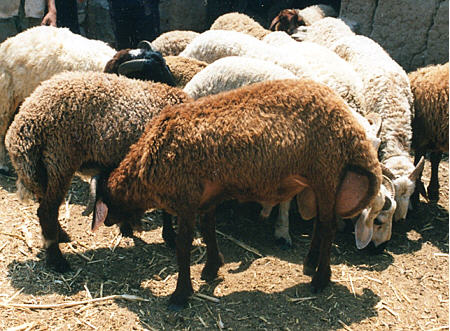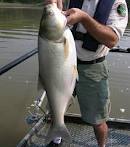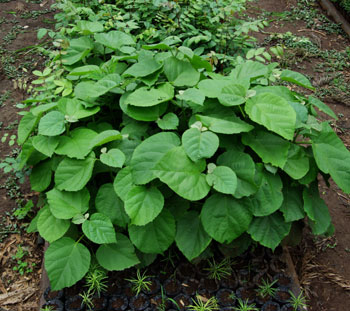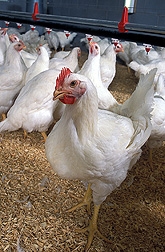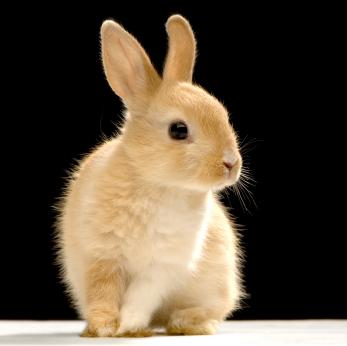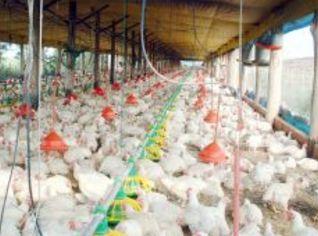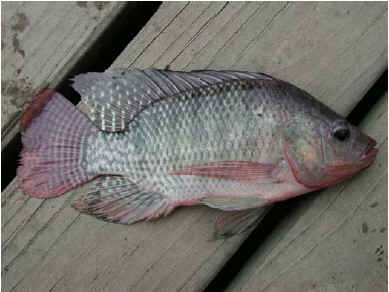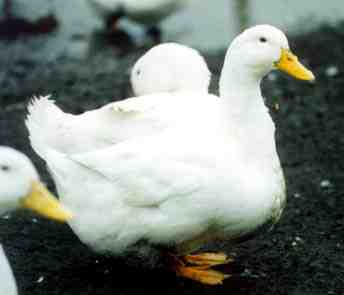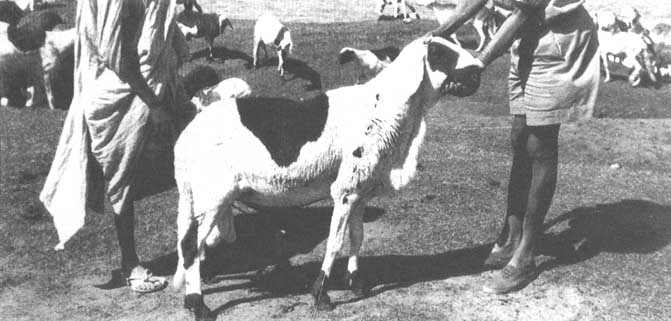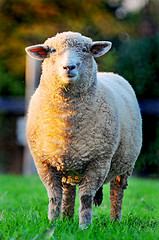Volume 2 : Issue 1 - January 2012
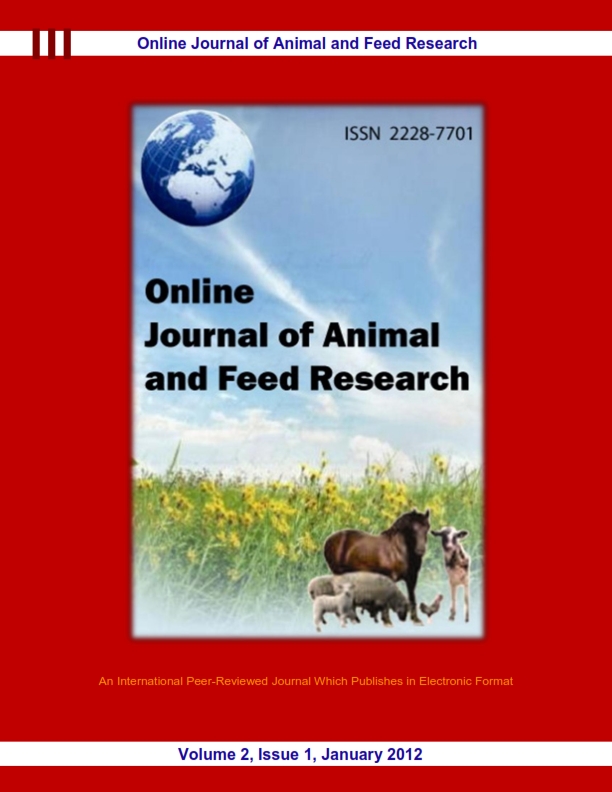
Table of Content, 5 January 2012
|
Research Title/ Field |
Article (Abstract) |
Download |
|
EFFECT OF DIETARY SUPPLEMENTATION OF Melissa officinalis and Aloe vera ON HEMATOLOGICAL TRAITS, LIPID OXIDATION OF CARCASS AND PERFORMANCE IN RAINBOW TROUT (Oncorhynchus mykiss) |
Original Research, B1 ABSTRACT: This was conducted investigate the effect of feeding lemon balm (Melissa officinalis) and Aloe (Aloe vera) on growth performance, hematological parameters and oxidative stability of rainbow trout. 360 uniform rainbow trout (20.87±0.25 g) were divided into 3 groups, and fed standard diets supplemented with ground lemon balm (2%, L group) or supplemented with Aloe (1%, A group) and without supplementation (Control, C group). Growth performance and body composition were not influenced by plant supplementation. Survival rate of fish was promoted in diets supplemented with herbs, significantly (P<0.05). A significant enhancement (higher value) of WBC and Hct was found in supplementation compared with control (P<0.05). However, any significant differences (p>0.05) were not observed in RBC and Hb in treatments (P>0.05). Results of thiobarbituric acid value (TBA) showed that lemon balm and Aloe herbs could be protective against lipid peroxidation in fish meat during chilling storage (4°C, 7 days). Key words: Lemon balm (Melissa officinalis), Aloe (Aloe vera), plants supplementation, Rainbow trout (Oncorhynchus mykiss) |
|
|
Growth and development of muscles, bones and fat of guinea fowl (Numida meliagris galeata)
|
Original Research, B2 ABSTRACT: This study was conducted to evaluate the growth pattern of muscles, bones and fat of guinea fowl. Eighteen day old chicks were reared for 22 weeks and serial slaughters were done every four weeks for evaluation. Results showed that the feed conversion ratio was 1:5, highest feed intake at 13-14 weeks of age and highest weight gain at 8-10 weeks. Carcass yield was 69%. The great mass of muscle was found in the thorax, highest bone percentage was found in the pelvis and the flank had high percentage of fat. Thorax and hind limb had high growth rate when compared with pelvis, wing, neck and flank. Key words: carcass yield, body regions, serial slaughter |
|
|
EFFECT OF SALT CONCENTRATION LEVEL AND SEASON ON CHEMICAL COMPOSITION OF WET-SALTED FERMENTED FISH SPECIES |
Original Research, B3 ABSTRACT: The study was conducted to investigate the effect of salt concentration level and season on chemical composition of wet-salted fermented product (local name; fassiekh) processed from new two fish species (Labeo spp, local name; Debs, Schilbe spp local name Shilbaya) compared with popular fassiekh fish species (Hydrocynus spp, local name: Kass), in reducing the over fishing and use of Alestes and Hydrocynus spp.in fassiekh production in the Sudan. A assorted of 12 Kgs of each of three fassiekh fish species group, consisted of Hydrocynus spp; (25 -30 cm in total length), Labeo spp (20 -25 cm in total length) and Schilbe sp. (17 -22 cm in total length) were collected from Jebel Aulia Dam landing. Fish species were transferred to Khartoum fishing company for processing of fassiekh product. The samples were divided into 3 batches with three replicates. Each batch was treated with different common salt concentration level (20%, 25%, 33% and 0% as a control). The findings of the study clearly revealed, the chemical composition of fresh salted-fermented product showed no significant differences between Labeo and Hydrocynus spp. while Schilbe sp. recorded significantly higher fat content. The salt concentration level on studied fish species resulted in an increase in crude protein and ash content than fresh fish. The highest salt level (33%) resulted in significantly lower moisture content, and produced well wet-salted fermented product with reasonably long storage shelf life. The effect of different season's production time on wet-salted fermented product showed no significant differences in final product of wet-slated fermented fish species chemically. But there were differences in the duration of processing time, depending on ambient temperature. The study concluded that, the best fish species for production of fassiekh product was the Labeo sp. in winter time with 25% slat concentration level treatment. The second and third were Hydrocyun sp. and Shelibe sp. respectively at the same slat concentration level of treatment and season time. Keywords: salt concentration levels, season, chemical, composition, wet- salted Fermented, fish species |
|
|
ANTI-NUTRIENT FACTORS, PERFORMANCE AND SERUM BIOCHEMISTRY OF BROILER CHICKS FED RAW AND FERMENTED ALCHORNEA CORDIFOLIA SEEDS
|
Original Research, B4 ABSTRACT: This study was carried out to determine some anti-nutrient factors in differently processed Christmas bush (Alchornea cordifolia) seeds and the effect of the processed seed meals on the performance and blood chemistry of broiler chicks fed from 1 to 35 day of age. Ground and fermented, and dehulled Christmas bush (CB) seed meals were analyzed for their anti-nutrient contents whereas ground and sieved (GS), ground-sieved and fermented (GSF) and non-sieved and fermented (NSF) seed meals were incorporated into starter broiler diets to replace 10% of maize, respectively. Fermented and dehulled CB seed meals contain 574.4 and 21.3mg/100g phytic acid, respectively. Cyanide was not identified in any of the meals. Dehulling eliminated the anthraquinone and tannin contents whereas fermentation only eliminated the tannin content. None of the methods completely eliminated the saponin, cardiac glycoside, flavonoid and alkaloid contents of the seed meals. With GS seed meal, broilers had lower average daily weight gain (P<0.05) than the control group. Feed intake decreased (P<0.05) but feed conversion ratio was not different when compared with control. Inclusion of GSF seed meal improved growth and feed intake when compared with the NSF seed meal and by day 35, growth and feed intake were comparable to those of the control birds. Blood plasma levels of alanine aminotransferase, alkaline phosphates and aspartate aminotransferase increased with GS CB seed meal diet, while serum calcium decreased. Neither raw nor fermented seed meals altered other measures of the blood chemistry. It is concluded that CB seeds contain toxic anti-nutrient compounds and that sieving out the hulls in the ground raw seed meal before fermentation improved the feeding value of the seeds for broilers at 10% replacement for maize. Keywords: Alchornea seed; Anti-nutrients; Broilers; Fermentation; Performance; Serum chemistry |
|
|
SURVEY OF PRODUCTION AND USE OF POULTRY LITTER IN KHARTOUM STATE, SUDAN
|
Original Research, B5 ABSTRACT: A survey of chicken litter production was undertaken by hand submitted questionnaire. The survey covered 219 farms out of 612 registered in Khartoum state to provide information on amount and use of litter. The survey revealed that most poultry farms followed similar management practices. About 58.94% of litter production was estimated to come from broiler houses and 41.06% from layer houses. It was estimated that 70% of the litter production is litter-based and about 30% are droppings collected without litter. The amount of litter produced was estimated to be 95097.58 ton/year and 87.1% of this amount was used as fertilizer. Samples of broiler litter were collected and proximate composition was conducted to investigate the nutrient quality of broiler litter. Results obtained on dry matter (DM) and ether extract (EE) showed that there are significant (P<0.05) differences among three locations (Khartoum, Khartoum-North and Omdurman). However, there are no significant differences on other chemical compositions. Key words: Poultry litter, survey, chemical composition. |
|
|
Regression Analysis of Linear Body Measurements on Live Weight in Sudanese Shugor Sheep |
Original Research, B6 ABSTRACT: In this research, linear regression models were improved for estimation of body weight using various linear body measurements from Sudanese Shugor sheep. Simple regression models were formed when Body weight (Bwt) was dependent variable and heart girth(HG), height at withers(HTW) and height at hip(HTH) as independent variables. The best derived regression prediction equation for estimation of body weight determinate by using beta (β) as the constant based on number of variables used for the equation, mean square error (MSE) and Coefficient of determination (R2). The model including the most appropriate measurements such as heart girth, height at wither and height at hip were the best fitted model( β = -47.54, MSE = 9.39 and R2=0.61) for estimation of body weight in Sudanese Shugor sheep in this study. Keywords: Linear body measurements, Body weight, regression analysis, Shugor sheep, Sudan. |
|
|
APPARENT DIGESTIBILTY COEFFICIENT OF PELLETED FISH FEED INCORPORATED WITH WATER HYACI NTH (Echhornia crassipes)
|
Original Research, B7 ABSTRACT: The objective of this study to determine the apparent digestibility coefficients (ADCS) of dry matter, protein, gross energy and fiber of five pelleted fish feed incorporated with different levels(0%,10%,15%,20% and 25%) of water hyacinth (Echhornia crassipes) on performance of red Tilapia fingerlings, using chromium dioxide as an inert bio- marker. Feeds were prepared to be iso-nitrogenous (35.00%± 0.20) and iso-caloric (kcal/kg 4700.00±0.52). Proximate compositions of test feeds, fecal matter and chromium contents also were determined. Results revealed the maximum value of ADCs for dry matter (DM) was found in reference feed (68.09%), while the minimum value was found in (test diet 4) 4 (50.36%). Similarly, the maximum ADCs values for crude protein content, gross energy, ether extract and crude fiber were found in control feed, while the minimum values were found in the feed 4. The survival rate was found to be significantly low among studied fish fed with feed 4. The study has shown that red tilapia efficient maximum digestion to nutrients is only up to 20% inclusion of water hyacinth in the feed. Keywords: Apparent digestibility, pelleted, water hyacinth and fish |
|
|
EFFECT OF FROZEN Daphnia magna DIET MIXED WITH PROBIOTIC PROTEXIN ON GROWTH AND SURVIVAL OF RAINBOW TROUT (Onchorhynchus mykiss) FRY REARED UNDER CONTROLLED CONDITIONS
|
Original Research, B8 ABSTRACT: Effect of probiotic Protexin was experimentally tested on growth and survival of rainbow trout fry reared under controlled conditions. Experiments to determine the effect of different levels of probiotic (2×104 (T1), 2×105 (T2) and 2×106 (T3) CFU/g-1) on growth and survival rates of rainbow trout in comparing with those of control diet containing no probiotic were carried out under laboratory conditions. In this trail, frozen Daphnia magna was considered as a basal diet for fry feeding. Rainbow trout offered the control diet exhibited the same growth and feed utilization with all experimental treatments, and no significant differences (P>0.05) in growth were observed among fish groups fed various levels of the probiotic. There was no effect of probiotic inclusion level on water quality. There was no effect of probiotic supplementation on survival at the end of experiment in T1 and T3, but survival rate in T2 was higher than other groups, significantly (P<0.05). Viability against high temperature stress was affected by dietary probiotic inclusion, as supplemented diets by probiotic revealed the better and more efficient results in fish survival. Viability of T2, T3 and control in challenging with high salinity was homogenous, while T1 showed the significant difference (P<0.05) with others, properly. Keywords: Probiotic, growth, survival, rainbow trout (Oncorhynchus mykiss) |
|
|
Relationships between haemoglobin (Hb) type and productive and reproductive performance of Rahmani ewes and lambs
|
Original Review, B9 ABSTRACT: Two hundred Rahmani ewes and seventy-one lambs used to study the relationship between the type of haemoglobin and some productive and reproductive traits. Distribution of Hb types and allelic frequencies were higher for type AA of ewes, while for lamb's type BB was higher than type AA. Fertility rate was higher in ewes with the type of haemoglobin AA than ewes with type AB or BB. Hemoglobin type, year of mating and breed of sire were not significant effects on fertility, while, age of dam and season of mating had a significant (P<0.01 or P<0.05) effect on fertility. Autumn season was the best season in fertility (84%) compared to (60%) in summer and (64%) in winter season. Ewes sired by Rahmani rams had the highest fertility (73%) compared to those sired by Chios rams (66%). All factors (Haemoglobin type, age of dam, year of lambing, season of mating, and breed of sire) had no significant effect on litter size at birth. However, ewes with Hb BB produced more lambs than either ewes with HB AB or ewes with Hb AA. Also, ewes aged 4 years had the highest litter size at birth. Ewes mating during autumn season produced more lambs than those mating during summer. Haemoglobin type was not significant effect on body weights of Rahmani lambs and F1 cross ½ C ½ R at all ages studied. Rahmani lambs with Hb AA had the lowest value of birth weight (4.05 kg vs. 4.14; 4.3 kg) compared lambs with Hb AB or BB, while lambs with Hb BB had highest weight at weaning , 6, 9 and 12 months of ages. F1 (½ C ½ R) lambs with Hb AA had the highest weight at birth, 6, 9 and 12 months of age, while lambs with Hb BB had the highest weight at weaning age. Haemoglobin type was not significant effect on daily gain at all periods studied for both Rahmani and F1 (½ C ½ R) lambs. Generally, Rahmani and (½ C ½ R) lambs with Hb AB had the lowest value of daily gain at all periods studied than lambs with Hb AA or Hb BB. Keywords: haemoglobin type, Rahmani ewes, reproductive performance |
|
|
gROWTH Performance of desert sheep under grazing conditions in NORTH KORDOFAN STATE
|
Original Research, B10 Online J. Anim. Feed Res., 2(1): 45-49, 2012 ABSTRACT: The experiment was conducted to study the effect of changing the nomadic husbandry practices during summer with feed supplementation and water restriction on the performance, carcass characteristics of desert sheep (Hamari sub type). Thirty desert sheep of about 8 month age were randomly allocated to three groups (ten animals each, 5 males and 5 females), group (A) watered daily and supplemented with concentrates, (B) watered daily only and (C) watered every 2- 3 days and was considered as control (the normal nomadic husbandry). The results included that average final live weights were significantly (P<0.05) different among the groups and were not significantly affected by sex but males in group A were heavier than the other two groups. The tail length, height at withers, heart girth, chest depth and body length were significant (P<0.05) different between the three groups. The average daily live weight gain was significantly (P<0.05) different among the groups, and the highest rate of gain was in A followed by B and C, respectively. The average daily live weight gains obtained were significantly (P<0.05) different between females and males of groups A, B and C. The males gave higher daily live weight gains than females. These results concluded that management strategy which involves shorter watering intervals and feed supplementation will probably reflect positively on the performance of Hamari sheep under range conditions. Keywords: Dessert sheep, growth performance, Body linear measurements, concentrate ration, Sudan |
|
|
SYNERGISTIC EFFECTS OF DIETARY GLUCOSAMINE AND PLANT / ANIMAL PROTEINS ON THE GROWTH PERFORMANCE OF ASIAN CATFISH (CLARIAS BATRACHUS) JUVENILES
|
Original Research, B11 S. Chowdhary, P. P. Srivastava, S. Mishra, A. K. Yadav, R. Dayal And W.S. Lakra ABSTRACT: A 84-days feeding trials was conducted to evaluate the use of animal and plant protein, in combination with glucosamine source for Asian Catfish, Clarias batrachus (av. wt. 0.22±0.01 to 0.24±0.07g). Six (31.18 to 43.51 % crude protein, 369 to 399 kcal/100g, and crude lipid 0.0 to 6.69%) practical feeds were formulated. The animal and plant protein component of the feeds was progressively added with glucosamine 0.0, 0.5, 5.0 and 10.0 % with fish meal, silkworm pupae, soybean meal and casein (F-1, PAG 0:100:0.5; F-2, PAG 0:100:5.0; F-3, PAG 0:100:10.0; F-4, PAG 100:0:0.5; F-5, PAG 100:0:5.0; F-6, PAG 100:0:10.0; The experimental feeds were fed to triplicate groups of fingerlings at 10% body weight per day and results were compared with control feed. Growth performance and feed utilization efficiency of catfish, fed with animal proteins are better than those of plant protein. The best growth among the animal protein group (F-1 to F-3) was recorded in F-2 followed by F-3 and F1 containing glucosamine @5.0, 10.0 and 0.05 %. Amongst the plant protein fed fishes showed best in F6 followed by F5 and F4. The survival was improved in glucosamine supplemented feeds ranging from 49 + 3.2 to 85 ±1.7 whereas the control showed 41±1.8 %. Results indicate that animal protein rich feeds were much acceptable than alternative plant protein sources for the Asian catfish, Clarias batrachus and the potential for replacing animal protein with soybean meal in the feeds of fish need more evaluation along with synergistic effects of growth promoter like glucosamine. Key words: Clarias batrachus, glucosamine, animal protein, plant protein, growth |
|
Induced Spawning of Silver Carp, Hypophthalmichthys molitrix Using Hormonal Analogues with Dopamine Antagonists
|
Original Research, B12 ABSTRACT: A study was made to investigate the effects of using carp pituitary extract, human chorionic gonadotropin, luteinizing hormone releasing hormone analogues (Receptal), with or without dopamine antagonists on the spawning performance parameters of silver carp. Results of the current study indicted successful induction of spawning silver carp using different spawning agents. The breeding response and fecundity were comparable among all treatment groups. Moreover, the current experiment clearly indicated that the use of hCG, or mammalian LNRH together with dopamine antagonists was more effective in induction of ovulation and increasing fecundity and hatching rate compared to the other spawning stimulators used in the current study. The results also demonstrated that using dopamine inhibitors potentiate the effect of the hormones used for spawning induction together with reduction of its dose (i.e. dose of carp pituitary extract, human chorionic gonadotropin). Meanwhile, it is well established that domperidone is preferred than metoclopramide as a dopamine antagonists for spawning induction of fish. In view of these results it is clear that not only carp pituitary extract, human chorionic gonadotropin but also the mammalian LHRH analogue (i.e. Receptal) was effective to induce spawning in silver carp. This is important in the view of the fact that mammalian LNRH analogues are available more widely and their price is much more attractive. This would result in cost reduction of induced breeding by using mammalian LNRH analogues in combination with a dopamine antagonist or alone. Keyword: Silver carp, induced spawning, human chorionic gonadotropin, luteinizing hormone releasing hormone analogues, dopamine antagonists. |
|
|
COMPARATIVE UTILIZATION IMPACT OF VARIOUS DIETARY LIPIDS, ON GROWTH INDICES, IN STRIPED MURREL, CHANNA STRIATUS (BLOCH) FINGERLINGS
|
Original Research, B13 ABSTRACT: A 84-day feeding trial was conducted to evaluate the utilization impact of dietary omega – 3 HUFA as a dietary energy source by fingerlings of striped murrel, Channa striatus on the growth study and tissue composition. There were seven treatments (L3HUF, H3HUF, MUSOL, LINOL, MIXOL, SATOL AND NATFO), each having two replicates, stocked with 100 fingerlings in circular plastic pools (300l capacity). The six feeds were formulated with basic ingredients (Soybean meal, 41%; soluble starch, 25%; Casein, 20%; carboxy-methyl-cellulose, 2%; papain, 0.5%; vitamin and mineral mix, 3.5%) with iso-energetic (19.3 kJ/g, F1-F6 ) diets and results were compared with natural food fed fishes. The isocaloric diets were formulated from semi-purified ingredients with six different types of oil supplement which were fed to replicate groups of fishes ad libitum. Based on the protein efficiency ratio (PER), specific growth rate (SGR), average per day increment (PI) and food conversion ratio (FCR), and, it was observed that C. striatus fingerlings utilized dietary lipid. The LINOL showing best growth performance followed by H3HUF, MUSOL on the basis of SGR and PER were significantly (p<0.05) influenced in striped murrel, Channa striatus. But lower SGR levels were obtained with diets containing L3HUF, MIXOL, SATOL and NATFO. This study suggests that the lipid from unsaturated origins could be effectively utilized by striped murrel fry with a better resultant growth. Key words: lipid, utilization, growth, Channa striatus |
|
|
Possibilities of using MORINGA (Moringa oleifera) LEAF MEAL AS A PARTIAL SUBSTITUTE FOR FISHMEAL IN BROILER CHICKENS DIETS
|
Original Research, B14 ABSTRACT: A six-week feeding trial involving 180 2-week old Cobb broiler chicks was conducted to partially replaced fishmeal with Moringa (Moringa oleifera) leaf meal. The birds were randomly assigned in equal numbers in a Completely Randomized Design (CRD) to four dietary treatments containing 0, 5, 10, and 15% Moringa leaf meal (MLM). Each treatment was replicated three times giving 15 birds per replicate. Feed and water were supplied ad libitum. The parameters measured include feed intake, final weight, weight gain, feed convention efficiency, carcass traits, hematology, serum biochemistry and meat quality.. Final weight, weight gain, feed conversion efficiency were significantly (p<0.05) declined with increasing level of MLM. None of the carcass traits measured was affected by addition of MLM. Mean corpuscular hemoglobin (MCH) was the only hematological parameter that showed significance (p<0.05) difference in treatment groups. Triglycerides, Low Density Lipoprotein (LDL) and Very Low Density Lipoprotein (VLDL) differed significantly (P<0.05). Also, Incorporation of MLM significantly (P<0.05) affected moisture, crude protein and crude fat of meat of experimental birds. Cost benefit analysis showed that incorporation of MLM increased profit margins. Based on the data obtained in this study it can be concluded that Moringa oleifera when partially used to replace fishmeal may hamper growth rate of broiler chickens. However, addition of MLM does not adversely affect mortality, carcass traits and blood variables. KEYWORDS: Moringa, Performance, Haematology, serum biochemistry and Meat quality. |
|
|
Evaluation of false yam (Icacina oliviformis) leaves on the growth performance of weaner rabbits (Oryctolagus cuniculus)
|
Original Research, B15 Online J. Anim. Feed Res., 2(1): 76-79, 2012 ABSTRACT: This study was conducted to determine the effect of Icacina oliviformis leaf meal (IOLM) on the growth performance of weaner rabbits. Twenty-one (21) weaner rabbits with an average initial weight of 661g were used in a completely randomized design. The feeding trial lasted for 56 days at the livestock unit of the University for Development studies. The chemical analysis was carried out at the Spanish Laboratory of the University for Development studies. The variables measured were feed intake, apparent nutrient digestibility and body weight gain. The average daily feed intake showed a significantly (P<0.05) higher intake for T2 (129.27g) compared with T0 (125.11g). Average daily body weight gain was significantly (P<0.05) higher for T0 (17.65g) compared to T2 (10.83g). However there was no significant difference (P>0.05) between T0 (17.65g) and T1 (13.33g).There was a significantly (P<0.05) higher crude protein digestibility for T0 (84.68%) compared to T1 (80.99%) and T2 (67.08%). Apparent digestibility for CP and EE decreased with increase in the level of IOL in the diet. Based on the results of this study, IOL can be used as a feed ingredient in the diet of rabbits at 5% without any detrimental effects. Keywords: Icacina oliviformis, Rabbits, performance, apparent digestibility |
|
|
BIOSECURITY PRACTICES IN ALGERIAN POULTRY FARMS
|
Review Article, B16 ABSTRACT: The objective of this study was to determine the level of adoption within the Algerian poultry farms (broiler chickens, laying hens) of a range of standard biosecurity practices (isolation, traffic control, decontamination, vaccination…). Quantitative and qualitative evaluation of the biosecurity in the poultry houses has been analyzed thanks using method developed by the French Food Safety Agency. Factorial analysis has permitted to determine four classes of poultry farms. Class 1 and 2 (55%) regroup poultry farms very badly maintained, with breeders which do not respect the elementary hygiene measures (precarious buildings, impure water, non-respect of the sanitary vacuum, badly disinfection, presence of contamination vectors, bad elimination loose chickens…). The two classes are a score between, 0 - 100 points and UFC (faecal streptococci) > 25. Class 3 and 4 regroup 45% of poultry farms and demonstrates that the number of faecal streptococci colonies /25 cm2 is the lowers (3<UFC<9) and (10<UFC<25) respectively. In these farms, the sanitary teams apply very rigorous barriers of security and decontamination. Visual score attributed for these classes represents unfortunately score between, 100-200 points. The decline of production performances (mortality, feed conversion, and laying rate) especially observed in the poultry farms, class 1and 2, because of failings sanitary barriers in production period. Keywords: poultry farms, biosecurity, production performances, Algeria |
|
|
Biochemical And Non-Specific Immune Parameters Of Healthy Nile Tilapia (Oreochromis Niloticus), Blue Tilapia (Oreochromis Aureus) And Their Interspecific Hybrid (♂ O. Aureus X ♀ O. Niloticus) Maintained In Semi-Intensive Culture System
|
Original Research, B17 ABSTRACT: Oreochromis niloticus, Oreochromis aureus and their interspecific hybrid tilapia (♂ O. aureus x ♀ O. niloticus) maintained under semi-intensive culture system were compared in a preliminary study to explore the variations in blood biochemical and non-specific immunological parameters. Comparisons were performed after one week of acclimation (“base-line” level). Serum cholesterol, albumin, SGPT and SGOT level were significantly higher (P < 0.05) in the purebred O. aureus than the purebred O. niloticus and their crossbred hybrid. The tested genotypes showed no significant difference (P > 0.05) in total protein, globulin and urea. Additionally, the levels of ALT and uric acid were significantly higher (P < 0.05) in both ♂O. aureus and the crossbred hybrid (♂O. aureus x ♀O. niloticus). On the other hand, the level of creatinine was significantly higher in the purebred O. niloticus followed by the crossbred hybrid and then the purebred O. aureus but still without a significant difference (P > 0.05) between the latter two genotypes. The phagocytic activity and phagocytic index were significantly higher (P < 0.05) in the crossbred hybrid (♂O. aureus x ♀O. niloticus) than the other purebred genotypes. The differences identified suggest that hybrid families from the two species would be used to construct a segregating population for genetic analysis of immunological traits in tilapia. But still, a larger sample size obtained from populations cultured under different managemental practices should be used and challenged to learn if the differences are large enough to produce a segregating population for genetic analysis of immunological traits and disease resistance. Keywords: Purebred, Oreochromis niloticus, Oreochromis aureus, inter-specific hybrid tilapia normal blood biochemical reference, phagocytic activity, phagocytic index. |
|
|
Production potentials and the physicochemical composition of selected duck strains:
|
Mini Review, B18 Adzitey F. Online J. Anim. Feed Res., 2(1): 89-94. 2012. ABSTRACT: Physicochemical composition of meat is an important factor in human nutrition and contributes to the choice of food by mankind. In recent times humans are much conscious of the health benefits of what they consume. Emphasize on the consumption of balance diets have been given much attention. The consumption of organic foods, vegetables, fruits, foods high in fibre, foods of animal origin with less fat and cholesterol are among the food stuffs being upheld. Poultry meat, eggs and products are widely consumed worldwide without much religious restrictions. The high consumption of poultry meat is partly due to it ease for preparing different dishes and the development of a wide range of processed ready-to-eat meals incorporated with chicken as a major protein source. Poultry meat (white meat) is known to be healthier than red meat probably due to its low calorie and lipid contents. Duck meat is comparable to that of chicken despite being red meat and it is a close alternative source of protein and other nutrients for humans. Duck meat is high in protein, iron, selenium and niacin; and lower in calories compared to many cuts of beef. This mini-review reports on the production potentials of ducks and the physicochemical composition of selected duck strains. It also reports on world duck population. Key words: Duck meat, consumption, health benefits, nutrition, physicochemical |
|
|
Effect of date pits on the performance of Sudanese desert lambs
|
Original Research, B19 ABSTRACT: Twelve Sudanese desert lambs with an average live weight of 20.9 kg were divided into three groups of equal number to study the effect of date pits level on the performance of Sudanese desert lambs. The study was conducted at small ruminant research unit in the Faculty of Agricultural Technology and Fish Sciences, Al-Neelain University Khartoum, Sudan. Three iso-nitrogenous and iso-caloric diets containing graded levels of date pits (0%, 5%, and 10%) were randomly assigned to the lambs groups. Feeding was on ad libitum for 45 days. Performance of experimental lambs did not significantly influenced with introduction of date pits. Key words: Lambs, date pits, chemical composition, performance |
|
|
Estimation of live body weight from linear body measurements for Farta sheep
|
Original Research, B20 Taye M, Bimerow T, Yitayew A, Mekuriaw SH, Mekuriaw G. Online J. Anim. Feed Res., 2(1): 98-103. 2012. ABSTRACT: A study, to develop regression models for prediction of body weight from other linear body measurements, was conducted in Esite, Farta and Lai-Gaint districts of South Gondar, Amhara region. Records on body weight (BW) and other linear body measurements (Body Length (BL), Wither Height (WH), Chest Girth (CH), Pelvic Width (PW) and Ear Length (EL)) were taken from 941 sheep. Non-linear, simple linear and multiple linear regression models were developed using Statistical Package for Social Sciences (SPSS version 12.0). For the multiple linear regressions, step-wise regression procedures were used. Predicting models were developed for different age, sex and for the pool. Positive and significant (P<0.01) correlations were observed between body weight and linear body measurements for all sex and age groups. Among the four linear body measurements, heart girth had the highest correlation coefficient (except ear length) in all age and sex groups which is followed by body length, height at wither and pelvic width. Heart girth was the first variable to explain more variation than other variables in both sex and age groups. The models developed had a coefficient of determination of 0.26 to 0.89; the highest coefficient of determination was depicted for male while the lowest was for dentition groups having two permanent incisors. Regression models in general were poor in explaining weight for the dentition groups above one pair of permanent incisors. Heart girth alone was able to estimate weight with a coefficient of determination of 0.77, for both sexes and the pool. The coefficient of determination of the fitted equations (in general) decreased as the age of sheep advances indicating that the fitted equations can predict weight for younger sheep with better accuracy than for older ones. In general, much of the variation in weight was explained when many traits were included in the model. However, for ease of use and to avoid complexity at field condition, it is possible to use heart girth alone as a predicting tool. As a method to estimate weight using linear body measurements, it is possible to use these linear body measurements for selection in an effort to improve body weight of Farta sheep. In addition, the difference in the correlation coefficients between weight and other linear measurements for different age groups indicates the possibility of using different body measurements at different ages to predict weight and use for selection as well. Key words: Farta sheep, body weight, linear body measurements, regression model |
| < Prev | Next > |
|---|





